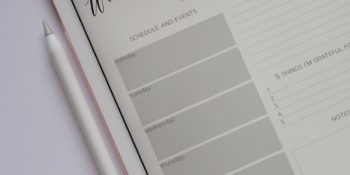Traditionally, project request processes are manual and time-consuming, involving endless email chains, spreadsheets, and verbal communications. And with no centralized process in place, keeping track of everything is difficult.
However, many of today’s project management systems offer teams of all sizes powerful tools to streamline and optimize their project request process.
In this blog post, we’ll explore:
- The ideal project request process
- Strategies to optimize the process
- How different teams use project request management
- And how project management software simplifies all of that
6 Essential Steps in Every Project Request Workflow
Step 1 – Ensure standard lead times are communicated effectively
When it comes to effective project request management, it’s critical that you identify standard lead times for each type of project request. Whether you’re overseeing a small team or a large corporation, standard lead times help to communicate to both the team and stakeholders what to expect; streamlining processes, enhancing productivity, and ensuring that projects are delivered on time.
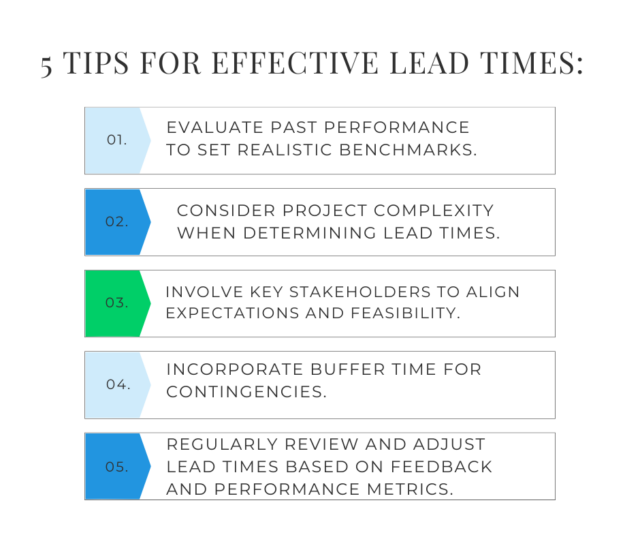
Step 2 – Submission of Project Requests
Typically, teams submit project requests through a haphazard conglomerate of meeting notes, emails, sticky notes, slack messages, and endless to-do lists.
By standardizing the intake process with a request form, you can streamline your workflow, minimize bottlenecks, and ensure every project receives the attention it deserves.
Example projects that are often requested cross-departmentally
MarComm teams often get many requests of varying needs from stakeholders on many teams. Items as simple as stationary or brochures and as complex as promotional campaigns, product launches, or events.
Related Content – Future of Project Management: Key Insights from Conversations with 50 Marketing & Operations leaders
Operations teams could manage requests for a myriad of different needs, including finance, maintenance, IT, HR, and more. These include security reviews, new software implementations, development requests, grant opportunities, or even employee engagement programs.
Customer Success and Support teams might receive requests for help onboarding new customers or training and supporting existing customers. Sales and Marketing may request help with customer success stories for marketing collateral or even for creating customer retention programs.
Step 3 – Review and prioritize requests
Once project requests are submitted, the team reviews and prioritizes them.
They prioritize projects that support overarching objectives, such as increasing sales, enhancing brand awareness, or promoting diversity initiatives. The team may also consider budget constraints, staffing capacity, and regulatory requirements.
Clear communication with stakeholders is essential during this stage to manage expectations and ensure alignment with institutional priorities. Project management software simplifies this process by connecting the project request with the relevant data, stakeholders, and deliverables, all in one place.
Step 4 – Develop a plan and strategy
After prioritizing project requests, teams develop comprehensive plans and strategies for executing approved initiatives, defining project goals, identifying target audiences, crafting messaging and creative assets, and determining the most effective channels for reaching the intended audience. Collaboration with internal stakeholders is critical during planning to ensure that efforts align with organizational objectives and values.
Step 5 – Implement the plan and execute the project
With plans and strategies in place, teams execute and implement approved projects.
For example, marketing teams oversee the production of creative assets, deployment of marketing materials, and management of advertising campaigns across various channels, including digital platforms, social media, print media, and events.
Due to the vast number of creative assets and campaigns that a marketing team may be running simultaneously, rigorous project management techniques, such as timelines, milestones, and checkpoints, are employed through project management software to ensure that projects stay on track and meet established deadlines.
Finally, Step 6 – Measure results and evaluate outcomes.
The final step in the project request process involves measuring the effectiveness of completed projects and evaluating their impact on organizational goals. Teams utilize a variety of metrics and key performance indicators (KPIs) to assess the success of initiatives, such as website traffic, engagement, event attendance, and sales numbers. They use data-driven insights to identify areas of strength and opportunities for improvement, informing future strategies and tactics. Feedback from stakeholders and post-project evaluations are also valuable sources of information for refining processes and optimizing outcomes.
The project request process is complicated, but the structure enables its success. From the submission of the request to the execution of the tasks to the evaluation of how the team accomplished its goals, it’s essential to have a process and program to track everything.
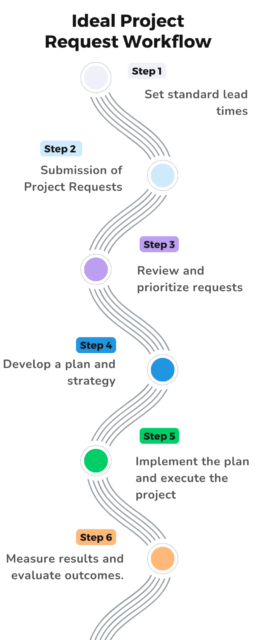
Project Request Optimization Strategies:
Now that we know what goes into the project request process let’s explore some strategies to make it more streamlined and effective:
- Offer due dates based on standard lead times
- Ask specific questions based on the request
- Attach request data in a project management system
- Have distinct criteria for prioritization
- Create project templates for common requests
- Provide regular updates on request status
- Solicit feedback from stakeholders
Offer due dates based on standard lead times
While it’s relatively commonplace to ask the question, “When do you need this by?” and many forms offer a calendar select field, not all forms allow you to set a standard lead time.
Utilizing Workzone’s request forms, you can take your request forms to the next level. For each type of request, you can set a standard lead time. For example, a brochure that needs to be designed and printed might take 20 days, while a social media graphic might take 2 days. By setting the lead time, you’ll prevent requesters from submitting unrealistic, last-minute requests.
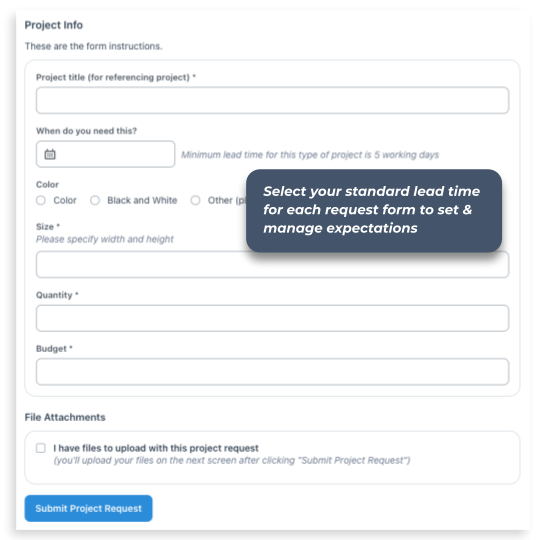
Asking specific questions based on request
You can simplify project completion by narrowing down exactly what’s needed and asking specific questions based on the type of request.
For example, a dean can use project request forms to simplify the process of requesting an advertisement to attract more students for the upcoming school year. Questions included in the form can narrow down essential aspects of the project, such as target audience, messaging tone, preferred channels, and deadlines. The form may inquire about the specific demographic the advertisement aims to reach, the key selling points of the college, and any branding guidelines that must be adhered to.
Attach request data in a project management system.
With a project management system connected to your project request forms, you can attach the request information and other relevant documents directly to the request. Allowing anyone who’s collaborating on the project to review the information quickly and avoid waisting time digging through email chains or searching in other systems.
Establish clear approval criteria.
A crucial part of making project request forms work for you and your team is to have clear approval criteria that lay out whether or not a project request will be approved and moved into production.
Have distinct criteria for prioritization
When designing project request forms, it’s essential to consider a range of criteria to prioritize projects effectively. Here are some key factors:
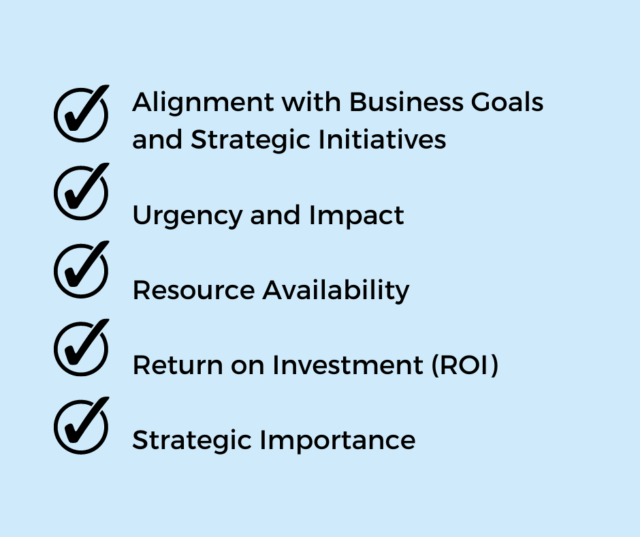
Create project templates for standard requests.
Initiating new projects often involves repetitive tasks and information gathering, leading to wasted time and inconsistent documentation. By creating templates, organizations can streamline the process, ensure consistency in documentation, and improve communication between stakeholders. Moreover, templates help gather pertinent details upfront, allowing project managers to make informed decisions and allocate resources more efficiently.
Provide regular updates on request status.
As you work through a project submitted through a project request form, it’s important to give stakeholders and requesters regular feedback and updates on how the project is progressing.
With project management software, the stakeholders can view the project information, including stopping gaps and problems. But, sometimes, it doesn’t make sense for the requester to have access to your project management software; in that case, it’s still vital to keep them informed about the project’s progress.
Solicit feedback from stakeholders.
Throughout the project lifecycle, soliciting feedback from stakeholders, including the project requester, is essential. You can continuously refine your project process from request to results.
Different use cases for project request workflows
Every team and department will use project management tools differently to achieve different goals.
Let’s dive into what a few of those use cases look like:
- Internal Marketing Teams, for example:
- Higher Education
- Hospitals
- Retail and Consumer Goods Organizations
- Agencies
- Operations Teams
- And more
Internal agency-type marketing teams at colleges, hospitals, or retail organizations
Higher Education Teams
In the dynamic world of higher education, marketing teams shape the institution’s brand, attract prospective students, engage current ones, and foster relationships. However, managing the myriad of requests and projects that come their way from many different departments can be overwhelming without the right tools.
Project request forms streamline communication in busy university settings, centralizing requests to avoid confusion and enhance workflow efficiency. It will simplify the interface and work with internal departments, external vendors, and campus leadership.
Related Content – 15 Higher Education Marketing Agencies To Help Your University Stand Out
Healthcare Teams
In the ever-evolving landscape of healthcare marketing, where patient engagement, brand awareness, and community outreach are paramount, efficient project management is essential. Hospital marketing teams juggle many tasks, from promoting services and events to launching new campaigns and initiatives. Amidst this complexity, project request forms emerge as a lifeline, empowering hospital marketing teams to streamline workflows, enhance collaboration, and drive impactful marketing strategies.
Hospital marketing is inherently collaborative, involving cross-functional teams from various departments and disciplines. Project request forms facilitate seamless collaboration and communication by providing a centralized platform for sharing project details, updates, and feedback. Through them, marketing teams can engage stakeholders, solicit input, and keep all parties informed throughout the project lifecycle. This transparent and collaborative approach fosters a culture of teamwork and ensures that everyone is working towards a common goal.
Additionally, in the highly regulated healthcare industry, compliance is paramount. Project request forms include fields for capturing regulatory considerations, legal requirements, and risk assessments, ensuring that marketing initiatives adhere to industry standards and best practices. They also promote accountability by documenting project ownership, timelines, and deliverables. With clear records of who requested what and when marketing teams can hold stakeholders accountable for their submissions and ensure that projects are executed promptly and compliantly.
Retail & Consumer Goods Teams
In the fiercely competitive world of retail and consumer goods, where customer engagement, brand visibility, and promotional campaigns are critical to success, efficient project management is essential.
Retail marketing teams face the unique challenge of coordinating marketing efforts across multiple locations, product lines, and channels. Amidst this complexity, project request forms emerge as a powerful tool, enabling retail marketing teams to streamline processes, enhance collaboration, and drive impactful marketing strategies.
By leveraging insights from project request forms, retail marketing teams can optimize their strategies, allocate resources effectively, and drive continuous improvement.
Client-facing teams such as creative agencies
In the fast-paced world of agencies, where deadlines loom large and client demands are ever-evolving, efficient project management is the key to success. Amidst the chaos, agencies rely on streamlined processes to ensure projects are delivered on time, within budget, and to the highest quality standards. The humble yet powerful tool is the heart of this efficiency: the project request form.
Project request forms serve as a bridge between clients, stakeholders, and internal teams. They provide a clear and structured format for capturing project requirements, objectives, timelines, and other pertinent information. This clarity helps avoid misunderstandings and ensures everyone is on the same page from the project’s outset. Project request forms often include fields for attaching relevant documents or assets, further facilitating clear communication and minimizing back-and-forth emails or phone calls.
Agencies gain greater visibility into their project pipeline by centralizing project requests through a standardized form. Project request forms typically include fields for tracking the status of requests, assigning tasks to team members, and setting deadlines. This transparency not only ensures that projects are progressing smoothly but also fosters accountability among team members. With clear records of who requested what and when agencies can hold stakeholders accountable for their submissions and ensure that projects stay on track.
Operations teams
In operations management, where efficiency, coordination, and strategic planning are paramount, streamlined processes are the backbone of success. Operations teams are critical in ensuring that organizational objectives are met, resources are optimized, and projects are executed precisely. Amidst the complexity of operational workflows, project request forms emerge as a valuable tool, empowering operations teams to streamline workflows, enhance collaboration, and drive operational excellence.
Operations teams often receive a multitude of project requests from various stakeholders, including department heads, team leads, and external partners. These forms provide a centralized platform for capturing and prioritizing these requests based on their strategic importance, resource requirements, and alignment with organizational goals. By standardizing the request process, operations teams can efficiently triage incoming requests, ensuring high-impact initiatives receive the attention they deserve while minimizing delays and bottlenecks.
Conclusion
Across the vast business world, there are thousands of use cases for project request forms and workflows like Healthcare, Higher Education, Retail Chains, Agencies, Operations Teams, and More. That’s why it’s crucial to simplify the process of collecting project requests by asking specific questions based on the project that’s being requested, attaching relevant data, graphics, and research to a request, and establishing clear approval criteria for what your team can and can not accomplish—having distinct criteria for how you prioritize requests—creating project templates for common requests, providing regular updates to stakeholders and soliciting feedback through the entire process.
And finally, the essential part is making sure that your entire process is communicated and stuck to.




